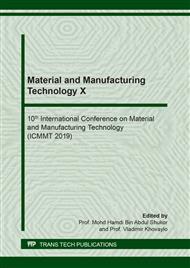[1]
K. Fuse and V. Badheka, Bobbin tool friction stir welding: a review. Science and Technology of Welding and Joining, 2018: pp.1-28.
DOI: 10.1080/13621718.2018.1553655
Google Scholar
[2]
Y. Chen, C. Liu, G. Liu, Study on the joining of titanium and aluminum dissimilar alloys by friction stir welding. The Open Materials Science Journal , 2011. 5: pp.256-261.
DOI: 10.2174/1874088x01105010256
Google Scholar
[3]
R.I. Rodriguez, et al., Corrosion effects on fatigue behavior of dissimilar friction stir welding of high-strength aluminum alloys. Materials Science and Engineering: A, 2019. 742: pp.255-268.
DOI: 10.1016/j.msea.2018.11.020
Google Scholar
[4]
M. Raturi, A. Garg, and A. Bhattacharya, Joint strength and failure studies of dissimilar AA6061-AA7075 friction stir welds: Effects of tool pin, process parameters and preheating. Engineering Failure Analysis, 2019. 96: pp.570-588.
DOI: 10.1016/j.engfailanal.2018.12.003
Google Scholar
[5]
L. Giraud, et al., Investigation into the dissimilar friction stir welding of AA7020-T651 and AA6060-T6. Journal of Materials Processing Technology, 2016. 235: pp.220-230.
DOI: 10.1016/j.jmatprotec.2016.04.020
Google Scholar
[6]
Abhinand, Numerical Simulation of Friction Stir Welding for Dissimilar Metal Welding. Materials Today: Proceedings, 2017. 4(10): pp.11265-11269.
DOI: 10.1016/j.matpr.2017.09.049
Google Scholar
[7]
J.-W. Choi, H. Liu, and H. Fujii, Dissimilar friction stir welding of pure Ti and pure Al. Materials Science and Engineering: A, 2018. 730: pp.168-176.
DOI: 10.1016/j.msea.2018.05.117
Google Scholar
[8]
A. Kar, et al., Effect of niobium interlayer in dissimilar friction stir welding of aluminum to titanium. Materials Characterization, 2018. 145: pp.402-412.
DOI: 10.1016/j.matchar.2018.09.007
Google Scholar
[9]
A. Kar, S. Suwas, and S.V. Kailas, Two-pass friction stir welding of aluminum alloy to titanium alloy: A simultaneous improvement in mechanical properties. Materials Science and Engineering: A, 2018. 733: pp.199-210.
DOI: 10.1016/j.msea.2018.07.057
Google Scholar
[10]
A. Esmaeili, M.K.B. Givi, and H.R.Z. Rajani, Investigation of weld defects in dissimilar friction stir welding of aluminium to brass by radiography. Science and Technology of Welding and Joining, 2013. 17(7): pp.539-543.
DOI: 10.1179/1362171812y.0000000044
Google Scholar
[11]
G. Buffa, et al., Friction stir welding of dissimilar aluminium–magnesium joints: sheet mutual position effects. Science and Technology of Welding and Joining, 2015. 20(4): pp.271-279.
DOI: 10.1179/1362171815y.0000000016
Google Scholar
[12]
R. Joshi, et al., Multi-Response Optimization of EDM for Ti-6Al-4V Using Taguchi - Grey Relational Analysis. Solid State Phenomena, 2017. 266: pp.43-50.
DOI: 10.4028/www.scientific.net/ssp.266.43
Google Scholar
[13]
J.Y. Kao, et al., Optimization of the EDM parameters on machining Ti–6Al–4V with multiple quality characteristics. The International Journal of Advanced Manufacturing Technology, 2009. 47(1-4): pp.395-402.
DOI: 10.1007/s00170-009-2208-3
Google Scholar
[14]
J. Kundu, and H. Singh, Friction stir welding: multi-response optimization using Taguchi-based GRA. Production & Manufacturing Research, 2016. 4(1): pp.228-241.
DOI: 10.1080/21693277.2016.1266449
Google Scholar
[15]
B. Parida, and S. Pal, Fuzzy assisted grey Taguchi approach for optimization of multiple weld quality properties in friction stir welding process. Science and Technology of Welding and Joining, 2014. 20(1): pp.35-41.
DOI: 10.1179/1362171814y.0000000251
Google Scholar
[16]
C. L. Lin, Use of the Taguchi Method and Grey Relational Analysis to Optimize Turning Operations with Multiple Performance Characteristics. Materials and Manufacturing Processes, 2004. 19(2): pp.209-220.
DOI: 10.1081/amp-120029852
Google Scholar
[17]
Optimizing SUS 304 wire drawing process by grey relational analysis utilizing Taguchi method. Journal of University of Science and Technology Beijing, 2008. 16(6): p.714.
DOI: 10.1016/s1005-8850(08)60276-5
Google Scholar


